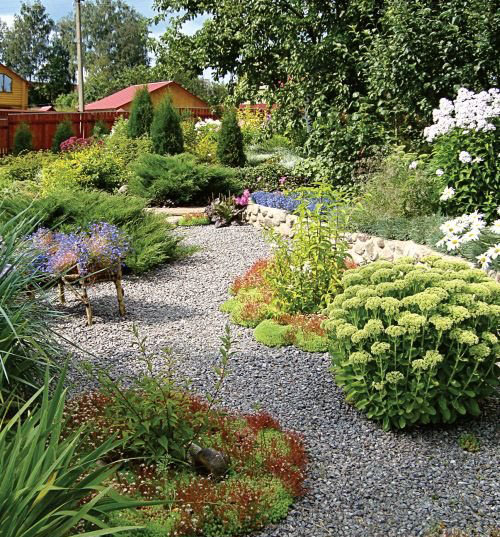Planning tracks and paving, design, selection of design, material. Putting tracks, garden paving plan
10 errors, design and construction of garden tracks.
There on unknown tracks ...
How to make tracks not only functional, but also beautiful?
Tired after a heavy rain jumping around the plot, jumping on the puddles, trying to reach the bath or shed? Then you urgently need to do a road trip. After you have decided on the location of buildings on the site, it is now worth thinking about how the track will go.
Error 1. Not the logicality of the route of the garden path.
Often on sites you can see the following: Going, you go and walk and the walkway is simply removed into the fence. Why it is needed, it remains a mystery. First of all, it is worth answering: where should the track lead me? Take your plan with buildings and draw the line path, based on the number of buildings on the site. So you will see the goals of your end route.
Error 2. Acute or very big angles when turning the track.
You can not rarely observe the following picture: the track goes straight, then turns and here you see a very sharp or big turn. The psychology of a person is arranged in such a way that we unconsciously choose shorter routes.
Not right: right:
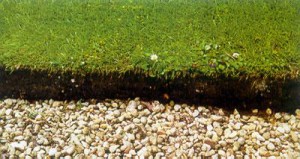

Where it leads? This means that all, especially small children will walk on the lawn and soon there is a shoulder. Yes, and with a garden trolley, you suffer to pass. So that this does not happen on paper about drawing several options for the tracks. So far, visually choose your most successful. When implementing on the site, arrange wooden stakes and pull the twine.

Before starting to dig a trench, go through the route. If you feel that somewhere I want to make a bend more or less, do not be afraid to change the location of the stakes. While you are not satisfied with the result, you should not start incarnation.
Error 3. Not taken into account style and color of the house when choosing a material for tracks.
If our goal is to create a harmonious and stylish plot, you should not neglect this. Sometimes you can observe the following: there is a bright yellow house on the site, and a poorest violet color is suitable for it. It looks too aggressive. Or all buildings on the site are made in different colors.
Not right: right:


So that this does not happen in advance, consider it. It is better to choose the material the same as in the facing of the house. When choosing a color, follow the rules: the color of the track color as well as the color of the house or use darker on the tone.
Not only color is important, but also the material. So for the house in the Russian style, the track made of wooden sleeps is suitable, for English -natural stone or tree. For Italian and Dutch styles: stone, tile, paving.

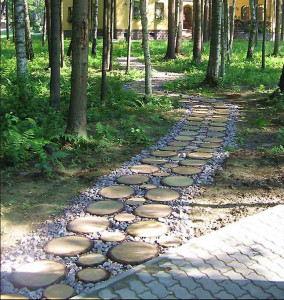
Error 4. Not matching the material of the track with its purpose.
Having made a beautiful paving for parking from tile, after a short period of operation, the appearance leaves much to be desired. Money is spent, and the result is zero? It is worth considering in this case primarily the functionality of the paving.
For parking, concrete, asphalt and paving slabs are perfect. If the concrete seems too boring you, use stencils with imitation of natural stone. So you can achieve the desired aesthetic effect. Pay attention to the thickness of the coating. So the layer of concrete for the pedestrian walkway will be sufficient to 50mm, for the tracks, which will ride garden cars up to 75 mm.
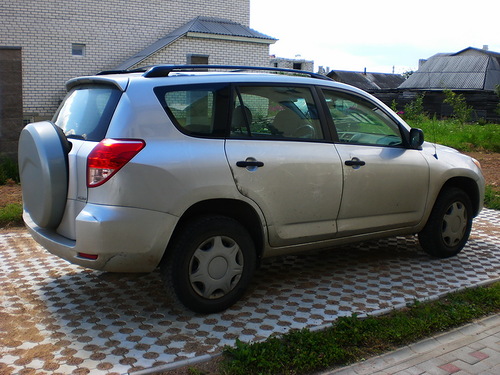
Error 5. No slope from the track.
The rain passed, and the puddles remained on the tracks? The problem is that you have not provided a slope for which the excess water will leave. So that it was not, when marking a track, use the construction level. Wide access roads and medium width tracks must be laid with a slight bias
(1: 40 or 1: 50), bilateral or one-sided towards drainage channels.
Garden tracks that connect various areas of the site, also make "horizons" or with a small bias in one direction. Long stages of durable material must have a small slope outward. The ratio should be no more than 1: 100. It is also necessary to provide drainage for the flow of excess water.
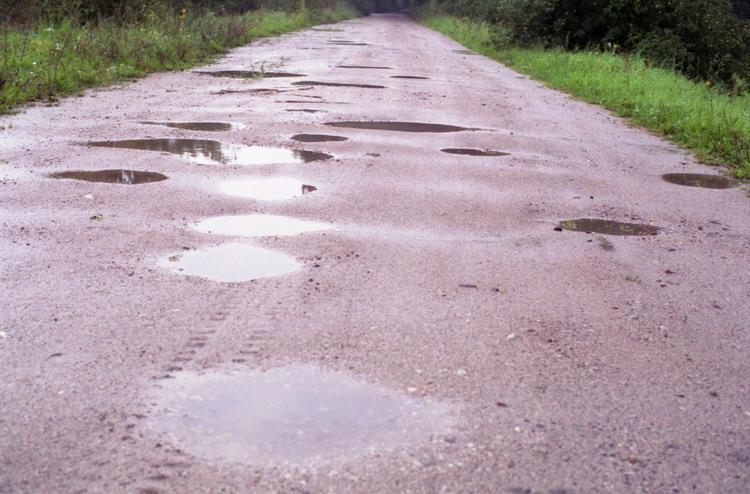
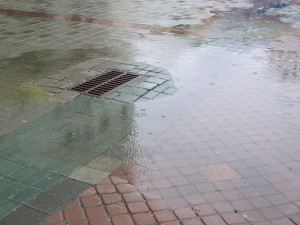
Error 6. The width of the track is not thought out.
Imagine myself what walking along the track you meet someone with a garden car. But alas you, not to disperse, because the width is calculated only for 1 person. You will have to go on the lawn, which will not quite be comfortable, especially after the rain.
So that such situations did not occur in advance determine the width of the track based on its purpose. If it is calculated as a pedestrian, walking track, it will be enough 55-75 cm. If it is not only a pleasure, but also working, i.e, you will drive around it with a garden car, then make a track of at least 92 cm Parking on 1 place Provide 230cm, and to parking for disabled people up to 350cm.


Error 7. Not taken into account the relief of the site, the peculiarities of the soil and the climatic features of this area.
It happens that after 1 spring track already requires repair. Somewhere formed gaps, cracks or some place failed, forming a pit. If you have bunched, moving soils, then for the track device it is best to choose bulk materials - crushed stone, explorer, gravel, etc.
Also for the device of the tracks on the bunched soils, the technology of the device of the monolithic concrete concrete is well suited (the reinforcing strapping will prevent the track surface cracking). From the device of step-by-step tracks and from the paving, it is better to abandon it initially, because they are the most "moving".
![]()
Error 8. The track is significantly higher or below the lawn level.
Do you look at the walkway and you get the impression that she failed?
Or vice versa, what "as if soared over the lawn"? The problem is that during the design, a natural relief of the plot was not taken into account. As a rule, geodesists cause to determine such heights and lowlands.
If the plot is flat enough, then try on initial stage Provide whether you will deliver or export soil. Consider that lawn will grow in the future on Earth, so the soil level can be immediately made by 2-3 cm below the track level.
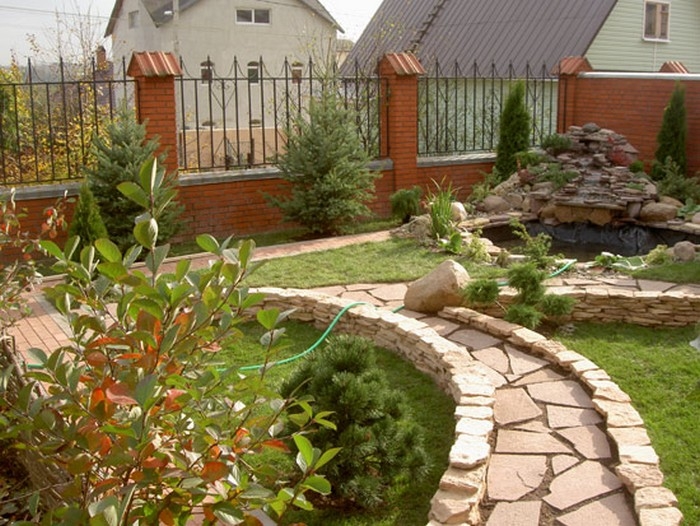
Error 9. The close location of the house and the garden path.
Of course, this is not always a mistake, and it happens that this is relevant not for all sites. But since it still happens, it is worth considering this moment. Around the house we make a very small scene and take the track next to the track. The effect of "oil oil" is obtained.
RIGHT WRONG:


We can only plant the lawn, but you are tortured to cut it with a lawn mower on such narrow plot. Therefore, it is worth increasing the width of the breakfast so that it is convenient to pass a person. Connect it from the main one by making it smoothly moving to the main track.
Error 10. Incorrect calculation of the amount of necessary material.
Mathematics Queen Science! It's hard to argue. It often happens that making a walkway, you understand that the materials are missing. You come to the market and discover that the desired color is no longer. Redo everything from the very beginning is not an option. Therefore, it is necessary to spend time in search of something similar.
In order not to complicate my life, do not save, and immediately buy more percent material for 20-30 more necessary. On the next year It may be necessary to repair individual fragments. It is better to protect yourself in this case in advance.
So what should be done to properly plan the tracks on the site?
1. Take your plan and pro enhance the track line. When turning, try to avoid sharp corners, and vice versa highly elongated circles. Get the beauty of the line on paper.
2. Play stakes on the site, and pull the rope according to the planned figure.
3. Come on the scheduled route, understand whether all you are satisfied. If not, rearrange the stakes until you get the appropriate result.
4. Calculate the track area, calculate the amount of the desired material. Add 20-30% for unforeseen work.
5. After all preparatory work Made, begin to embody the conceived.
6. Be sure to think about the lighting of the tracks so that you can walk without fear and in the dark. Especially in winter, when the day is much shorter. To do this, lay down small lamps on solar panels, so you can not only light, but also to emphasize the beauty of the track.
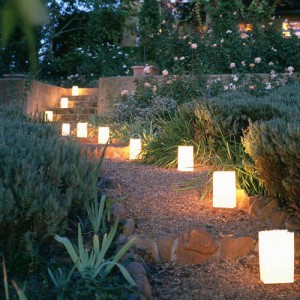

Take a plan with intended buildings and pro draw the tracks based on the number of buildings on the site.
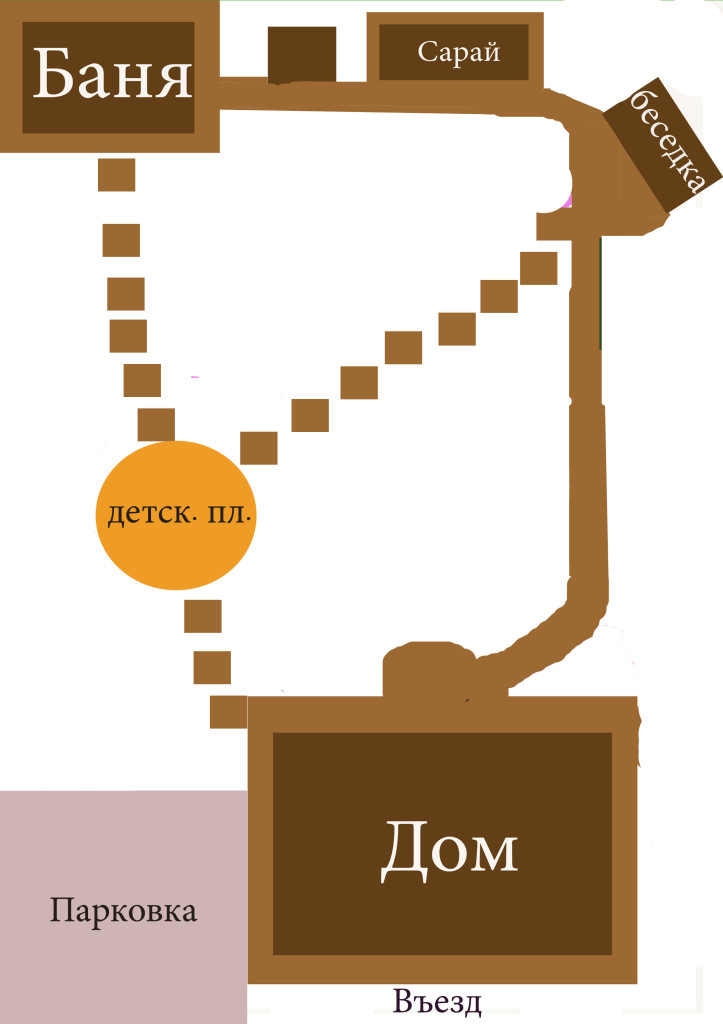
In the next topic, I will disclose the principles of creating flower beds and decorative groups.
Write in the comments, what kind of decorative paving you choose? Why picked up it?
In addition to the fact that the tracks in the garden are designed for the convenience of overcoming its space, the paving path also carries another function - creates an original garden drawing. The location of the tracks and paved sites emphasizes the general landscape style of the site, the color and textural solution of the house and other buildings. The pavement type of tracks is selected depending on their functional purpose, the overall concept of design and preferences of the owner of the garden plot.
Development of the project plan
Studio landscape design "Apple-garden" offers services for design layout planwhich includes counting the pavement area, the description of the used paving materials.
The paving plan with the description is included in both the basic and advanced set of project documentation, but it is possible to order it with separate sheets, which is laid out into the polystyt system of payment of our landscape design services.
Every time, driving past construction markets, we see endless stands with artificial stone and paving slab, piles of natural cobblestones and colored gravel mountains. How to choose a suitable stuff material in your garden? First of all, it is necessary to take into account the size and shape of the garden plot. If your plot is small in the area and has wrong shapeThe material that creates a texture, for example, clinker brick or blocking, cobblestone, pebble or gravel, will be powered for paving. If your site has a large territory, then you need to use such material as concrete or stone plates.
Modern and originally looks skillfully selected combination of various types garden paving . This technique visually increases space and positively affects the artistic perception of the garden as a whole.
When choosing a material, climatic features should be taken into account in the part of the garden, where the paving is used. It is impossible, for example, to use a tree in the shady and wet part of the garden, such a track will quickly come into disrepair, covered with moss and mold. The use of bricks in the crude part of the garden will reduce the decorativeness of the material, it will acquire a gray-green color. A monolithic concrete can crack with a sharp drop of temperature. In order to avoid such trouble, trust the design work paving tracks Professional landscape studio.
Types of garden paving tracks
"Beautiful stones, like flowers, always raise the mood"
V.A. Supratchev
Billing with clinker bricks (clinker paving)
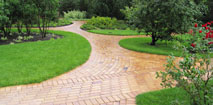
Type of paving paving a paving rather time-consuming and expensive, but it is compensated by its high quality and refinement. Combination of the color of blocks and paving options can be achieved by an infinite set of drawings.
Powerboard concrete slabs
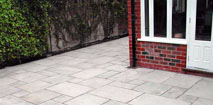
Concrete slabs are the most common and inexpensive way of covering garden tracks. The plates themselves are made of various sizes, shapes and colors, up to simulation of other materials, such as wood (decozzeton).

Contrary to the belief that the concrete surface has an unattractive view, there are many ways to decorate it. This is imitating brick or masonry with a special cutting; cladding of monolith tiles; trim pebbles, gravel, glass elements or fragments ceramic tile by pressing them into the wet concrete; artificial composure of concrete; creating a rough surface; Coloring.
Paving plates from natural stone
![]()
Breeding natural stone is suitable for any landscape style, whether natural, regular or modern type Garden. This type of paving is one of the most durable and practical. Natural stone combined with various species paving. Especially noble looks like a combination of natural stone and bricks. Along with the tumor, the material is widely known is the granite blocking.
Wooden paving
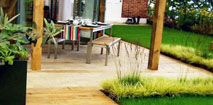
Currently, wooden tracks and floorings are increasingly used in the landscape design of the site. Many this type of paving will seem impractical, but it is not. Modern technologies Allow special processing in which the tree can serve you to thirty years old.
In addition to environmental advantages, wooden paving bears on itself and functional load. This material is very often used for the design of the terraces, patio or paving around the pool.
In our climate, it is advisable to use a larch with incredible durability, even with harsh operating conditions. The reason lies in large quantities The comedians present in the wood that protects it from rotting.
In modern landscape design Wood is used in its various interpretations. It is a garden parquet, and wooden sleepers, round-shaped hemps, transverse spins of thick trees, rectangular wooden chocks and a tree bark.
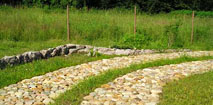 Paving the tracks by cobblestone
Paving the tracks by cobblestone
The paving path of the cobblestone, especially in combination with a wooden flooring, is best suited for Japanese landscape style. With a cobblestone, you can create a unique and elegant pattern.
Paving pebbles or gravel
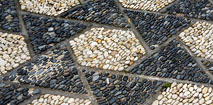
The main advantages of the gravel paving tracks are its naturalness, versatility and reasonable value. Gravel coating makes it possible to give tracks any shape. To tie the track from pebbles or gravel with basic paving, it decorates the stones with plates. In addition, such plates will prevent the displacement of small stones and will not give a bulk material.
Lawn lattices

Lawn lattices are a novelty in Russian gardens. They are used not only when placing parking for cars, but also when creating green tracks or garden lungs. In addition, in the grille cells you can sing lawn grassThey can be filled with small gravel. In this case, you will receive a durable gravel platform on your site.
Step-by-step paving
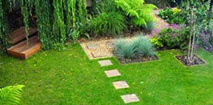
Step-by-step pavement is usually used to create auxiliary tracks. For example, the path of your following lies through the open lawn, in this case you should not "cross out" the space by the monolithic lines, much more appropriate will pave a step-by-step path. It is illicitably perceived much easier and does not divide the plot falling in the field of your vision, on the part.
The second point - you noticed that we move very much in the garden plot? From here it follows that the tracks in the garden should be a lot. Now imagine that we have slaughtered our entire path with monolithic concrete, stone or brick. Whether we have a space for contemplation, will you distract us here and there are "road ribbons" arising? Here in this case and necessary step-by-step tracksthat will be barely noticeable against the background of lawn or any other type of herbal cover.
There is another reason why step-by-step paths in the garden paving are necessary. Tracks ask direction to look. The clearer track lines, the more our look clings for them. But we all have on garden sites There are places that we would not want to set a deposit. It can be both a secluded gazebo and an unsightly compost pile. And if there will be a solid paths to these places, the unwittingly of your glance and the look of your guests will rush exactly.
Our company will gladly take on the design of the tracks on the site, as well as the full cycle of their construction - from the centering work to the stump of stone or sidewalk.
The beginning of work on the construction of the tracks.
Taking into the hands of working documentation of the project of improvement, we find a center drawing, where the location, dimensions and purpose of paving sections are reflected, as well as drawing with the designs of road clothing and the specification of material for paving.
All work related to the paving and the device of tracks and sites, begins to mark the geometry and preparation of the base for power.
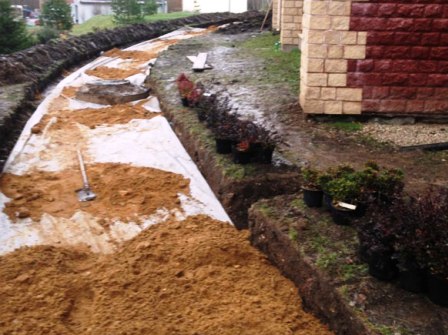
Decorative pavement tracks makes a plot more attractive and well maintained, makes it possible to emphasize individuality with different materials and color contrasts.
Paving slabs and paving slabs used by the "New Manor", selected specifically adapted to view physical exertion. The use of rough paving slabs in the pavement tracks is convenient and for the zone of vehicle entrance. Smooth and glossy, paving slabs can freely fit in those areas where there will be no transport to ride.
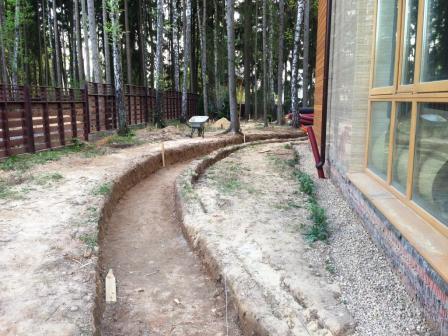

Choosing a base for power paving or tile.
Concrete or not concrete?
"Cutting without waiting for a passion" that in a free interpretation means "concrete is obligatory and thorough" - a fairly common opinion of the mothers of builders.
Indeed, for the Moscow region is mostly characteristic and clay soils. During seasonal primers, it is a concrete basis that can protect the path from the destruction of the decorative top layer.
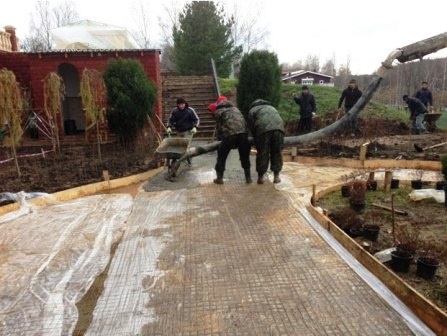
For coatings on which the car movement is planned, the concrete layer is usually poured with a minimum thickness of 20 centimeters with double reinforcement to the prepared sand-gravel pillow, enhanced by geotextiles. Such a "pie" will not fall asleep over time, does not form a key, retain the initial slopes for surface drainage.
And a pedestrian walkway? Here - not everything is so unequivocal.
If you want to use a stone or paving slabs with a thickness of 50 millimeters, but a sufficient reason can serve as a compacted pillow from the sand-gravel mixture. AND no concrete! 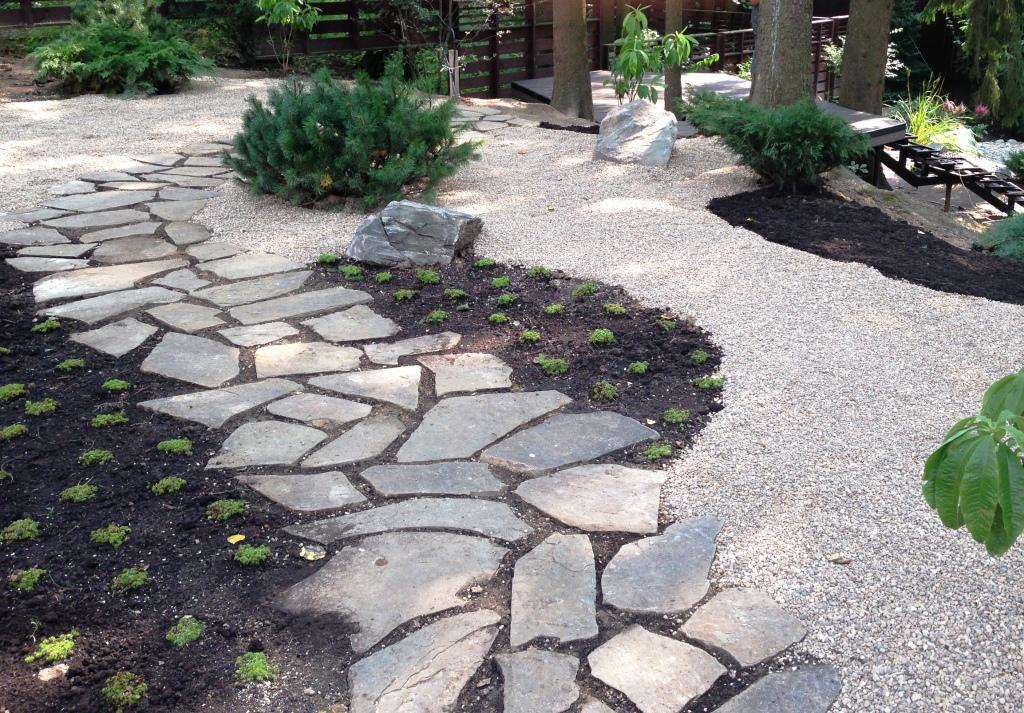
This is the latter and much more environmentally friendly. Your plants will tell you a lot thank you for such a choice.
The only thing - do not save on the drainage layer and more carefully tamper the gravel base.
And of course, do not forget to divide the underlying geotextile layers. Thus, the track will become stronger.
What material do we use for paving tracks?
The building materials market represents many types of natural and artificial coatings.
- Granite dropout.
Inexpensive, at the same time as simple as possible and effective option. Used for the device of so-called "soft" walking tracks. So that the track does not crumble, the border is desirable around it around it. The track is based on PGS and other bulk materials. Consider, however, that the upper layer will be distributed throughout the site.
- A natural stone - Granite, limestone, slate, sandstone, etc.
The durability of the sites quite justifies the spent resources. The most popular in the field of pavement paths sawn or the crotes of granite blocks. It is resistant to shocks, temperatures, water and pressure. The thermo-treated surface has roughness and do not give slide. The use of granite complete paversing will bring solemnity to the garden.
The following material is a flat stone of different sizes. For small or thin (20-30 mm) stones need a concrete basis. Thick and bodies are frozen perfectly look at the tracks "Russeck" with a lawn between the plates.
- Clinker paving (clinker brick) or just clinker - Natural thermally processed clay.
- Termevice.
Resistant to destruction (mold, rot). Due to attractive external view It is widely used to create embankments, outdoor terraces, sometimes the pavements of garden tracks. From the thermalvisian, we made a coating of the embankment.
- Vibrating and vibropressed cement tile.
The first species is characterized by a huge selection of colors and forms, but at the same time absolute instability to physical pressure. Used, mainly for the paving garden tracks. The second type of tile cannot boast of the same diversity, but is distinguished by resistance to temperatures and durability. In demand in the improvement of sites to which various weights will be affected (for example, parking lots). To reduce pressure and to avoid faults, it is better to use a small blocking instead of large plates.
- Wood-polymer composite (DPK) - Material combining the best quality wood and plastic, is resistant to any weather.
A variety of available colors allows you to enter such a track in any garden.
- Decorative concrete.
This material generally gives a huge space for creativity. Special stamps will create their own design.
Specialists of the company "New Manor" perform the paving slabs on the turnkey section, speeding up the process of landscaping the gone.
Unquestioned compliance with the production technology of works by highly qualified specialists using qualitative materialsAllows the "new estate" to count on the perfect result and eliminates the customers from the need to repair in the near future.
Track design includes several stages.
Firstly, the types of pavements must be coordinated with the garden style, in order for the insertion territory and the tracks into the general landscape. Based on the garden style, the design of the garden paths is selected: material, outlines, paths, material color, and drawing pattern. So, in regular, Italian and Moorish gardens tracks on cottage plot There must be strict geometric forms, with clear boundaries and the right pattern.
In the landscape and rural gardens, the tracks are better to make winding, with smooth bends; The color of the pavement should not break the natural harmony, but to connect the natural and created person on the site. In the garden-modern, on the contrary, sharp transitions of colors, their contrast combinations, monophonic clean colors, combinations of different textures.
The tracks in the Japanese garden do not make straight; The color of the tracks B. eastern Gardens It should not be bright and screaming, but on the contrary, calm, giving a feeling of comfort, warmth and harmony. Strict formal tracks are good on large areas, and natural, with smooth bends, garden tracks visually increase the plot, so they will look good in small gardens.
Road projects are applied to general drawings, they indicate the area of \u200b\u200bpaving, its type, construction and vegetable compositions. The drawing must be compiled to think over all the details and do not redo anything in the future.
About where to lay garden tracks, to solve you; In particular, it depends on the design of the entire garden and the objects located on it. Country tracks protrude the binding element in the gardens, they connect the construction and compositions on the site and give the garden completeness. Garden and park tracks can be laid through the shortest path (between the house and a bath or summer kitchen, for example) or vice versa to make long walking alleys, for which you can walk and enjoy the beauty of the garden; In this case, garden tracks are our locality guide.
In addition to the style of the garden for the paving garden tracks, it is important to take into account the future load on them. Therefore, in different zones of the garden use different material For garden tracks. For example, in the economic zone and where the tracks are used most often, you need to use the most durable packing materials. The track leading from the wicket to the house and the paths located in the front part of the garden should be wide and most beautifully decorated; With a combination of materials or with complex drawings. Technology device of garden tracks that are less common is much easier; For their paving, you can use soft materials.
Materials to the topic:
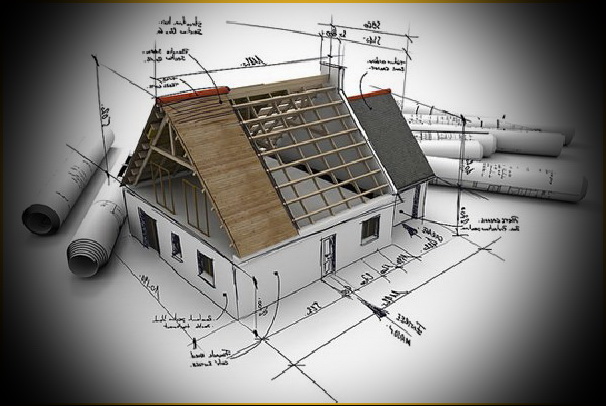
|
If they decided to build ... To read... | 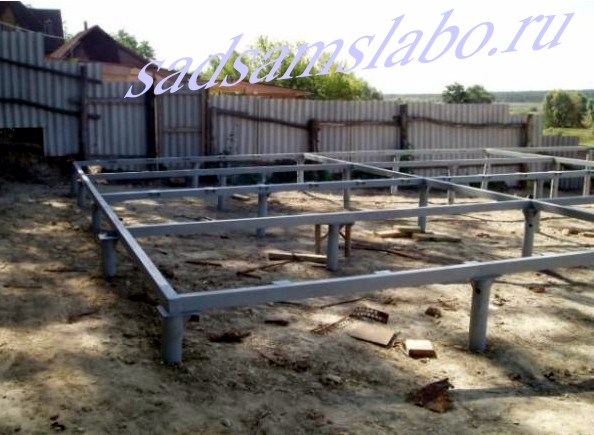
|
The main durable foundation ... To read... | We build a bath ... To read... | |
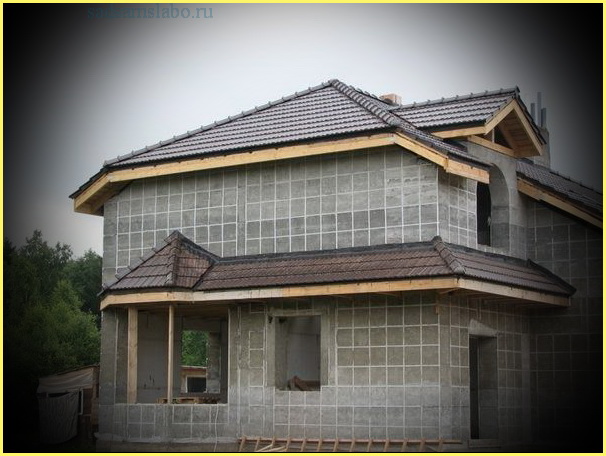
|
What to build walls ... To read | 
|
Build a fence according to the rules .. To read... | 
|
In order not to go the roof ... To read... |
Power facilities are used in important garden zones: recreation area, barbecue area or summer kitchen, patio, sports and playgrounds, where heavy and massive items are installed, for example, benches or sculptural compositions, vases, fountains (in order to avoid pumping of lawns ).
We plan a track
The first stage of the path of the track, regardless of the coating, is to develop a route of movement on it. First of all, any track should lead somewhere - whether it will be a barn, a decorative sculpture or just a transition from one zone to another.
A straight or angular track will split the garden into segments and give them a regular form, unlike winding, which is characteristic of a breastplate of a more natural type. It must be remembered about the nature of the relief under the track. If the slope of the track, for example, is directed towards the house or other construction, they will be poured with rainwater.
Draw a large-scale plan, pointing to enhance it and lower the level of land in order to make it easier to determine the direction of the tracks and bypass obstacles.
Keep in mind that the curved track of the track on the plan may look different than on the ground, where the bend can be practically inconspicuous. In order to imagine how the track will actually look like, bring the plan close to the eyes and look at the bend.
Place the track
If you are going to pour the path with a completely concrete solution or lay out it with tiles, you first need to be placed on the ground using a twine, stretched between the spikes (or with the help of a long garden hose). Use the purpose of this track: if it is worth carrying cars, then the width It must be appropriate, and for the passage you will need a walkway with a width of about 92 cm.How to place the bends of the tracks
The track, smoothly looping all over the garden, will decorate any design. She invites you to take it to the end, promising secluded corners or something interesting for the next turn. Forest should have smooth and wavy bends. If it turns too sharply, it will be difficult for it to carry, for example, a wheelbarrow. The route of such a track can not be paved without a plan on the scale, as well as to determine its size, as well as calculate the number of necessary materials.Twine
Tensioning one twine, tieding it to a peg, along the longest side of the site, where the track will be laid, and the other - at right angles to the first - in the width of the site. To establish the location of the indicative pegs, set aside along these lines intermediate perpendicular lines at the same distance from each other, corresponding to the scale of your plan. Between the indicable spikes, stretch additional beeps to create on the form of the shape, drawn on the plan. If pegs and the twine will need to be removed to remove the fertile layer, return them later into place, as they can serve as the basis of formwork if necessary.
If it is planned to pour a winding path with a concrete solution, we will have to build a suitable wooden formwork. The best use boards with a thickness of 2.5 cm or thinner (king them more pegs). The height of the formwork boards must correspond to the depth of the proposed concrete fill. They need to make inscriptions (up to the middle of the thickness) throughout their width at a distance of 12.5 cm so that they are easier to be bend to impart the necessary form. Additional pegs in the ground to provide the desired formwork form and give it more hardness. The pegs are naked with the outer side of the formwork. For smooth bend, the inspirations should be from the outside of the formwork, and for the sharp need to make cuts on the inside of the bend, so that the tree is not cracked.
